What is ECE R10?
ECE R10, Regulation 10, R10 or UNECE R10 is one of the automotive regulations published by The United Nations Economic Commission for Europe (UNECE) which has 56 member states as of 18 February 2020. ECE R10 is defining Electromagnetic Compatibility (EMC) requirements of the vehicles and electronic sub assemblies (ESAs) used in automotive. It is listing required EMC tests and type approval certification (E marking) process for electronic components, systems and vehicles used in automotive. Every designer, engineer, manufacturer, exporter, importer acting in automotive shall be aware of this regulation since it is used for product compliance.
Which products are under the scope of ECE R10?
As given on the scope of ECE R10, the regulation applies to:
1.1. Vehicles of categories L, M, N O, T, R and S1 with regard to electromagnetic compatibility;
1.2. Components and separate technical units intended to be fitted in these vehicles with the limitation given in paragraph 3.2.1. with regard to electromagnetic compatibility.
1.3. It covers: (a) Requirements regarding the immunity to radiated and conducted disturbances for functions related to direct control of the vehicle, related to driver, passenger and other road users’ protection, related to disturbances, which would cause confusion to the driver or other road users, related to vehicle data bus functionality, related to disturbances, which would affect vehicle statutory data; (b) Requirements regarding the control of unwanted radiated and conducted emissions to protect the intended use of electrical or electronic equipment at own or adjacent vehicles or nearby, and the control of disturbances from accessories that may be retrofitted to the vehicle; (c) Additional requirements for vehicles and ESAs providing coupling systems for charging the REESS regarding the control of emissions and immunity from this connection between vehicle and power grid.
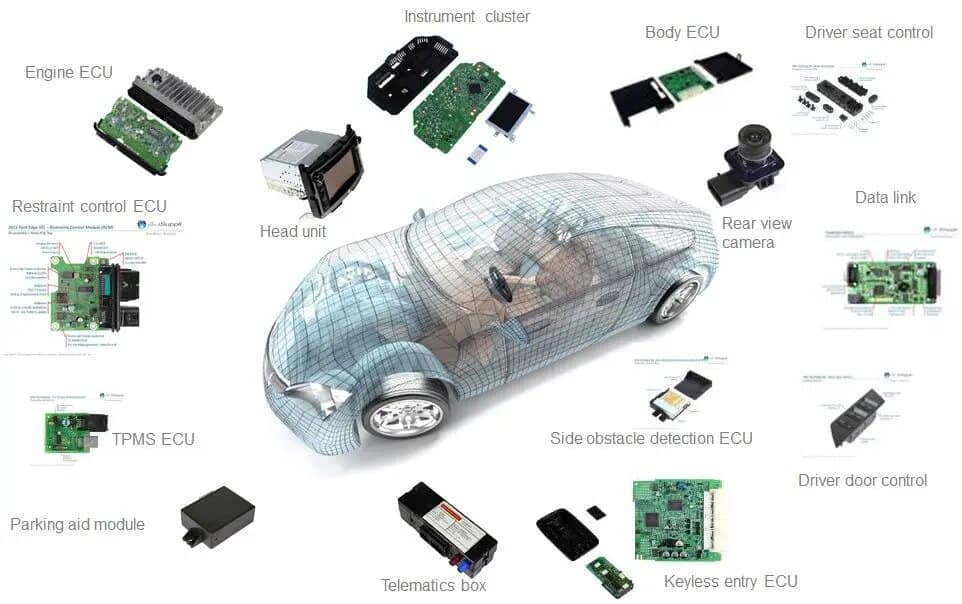
Which versions of ECE R10 are published?
Version of ECE R10 is mentioned as ECE R10 Rev.6, ECE R10 Rev.5 or ECE R10 Rev.4. The latest version is Revision 6 and it has been officially published by UN ECE. On 30 October 2020, United Nations published Amendment 1 for ECE R10 Rev.6. On 28 December 2022, Amendment 2 for ECE R10 Rev.6 is published. ECE R10 regulations and its amendments are free documents, you can download them by visiting official website of UN ECE. However, you can not reach test standards mentioned in the regulation since most of the test standards are not free of charge. If you need to check the details of standards you have to purchase them from web store of the standard publisher. Alternatively, you can ask Testups any technical questions about the tests.
ECE R10 Rev.7 is not published yet. The regulation committee is still working on it and draft version is released for review. Some essential changes, like testing EMC radiated immunity tests up to 6 GHz, are coming soon. When Revision 7 of UN ECE R10 published you will see the differences on our dedicated web page. Download Draft version of UN ECE R10 Revison 7.
What are the other automotive regulations published by UN ECE?
ECE R10 is not the only regulation published by UN ECE. There are 160 automotive regulations published by UN ECE. Each regulation specify requirements of the different types of vehicles or components that will be used on that vehicles. For instance, ECE R28 is for audible warning devices, ECE R97 is for vehicle alarm systems (VAS), ECE R100 is for electric power trained vehicles, ECE R116 is for anti-theft and alarm systems, ECE R152 is for advanced emergency braking systems (AEBS). Your product may fall under the scope of more than one regulation depending on its features, functions and field of use.
Different Language Versions of ECE R10
There are three language options for ECE R10 regulation published by The United Nations Economic Commission for Europe (UNECE). You can click below links to reach English and or French versions:
ECE R10 Rev 6 Deutsch is not available. However, you can get some general information about ECE regulations in German by clicking here.
When do you need ECE R10 Testing?
If you are an engineer, technician, quality responsible, technical manager, product manager, certification manager, or anyone responsible for the product’s compliance acting in automotive, your electrical and electronic products may fall under the scope of ECE R10. If you would like to market and sell your electronic products and vehicles used in automotive in ECE R10 countries, your product should comply with this EMC regulation. Since ECE R10 is mainly an European regulation, it covers all Europe but it is also covering non-European countries. We call the countries accepting ECE R10 ‘ECE R10 Countries‘ If you would like to market your products in these ECE R10 countries, passing ECE R10 tests and having an ECE R10 compliance test report would prove its electromagnetic compatibility. If the type approval certification (E-marking) is also asked by your market (your clients, buyers, prospects) or the Regulation 10 itself, in addition ECE R10 test report, you need a type approval certificate showing an unique E mark assigned to your product. Thus, ECE R10 testing might not be enough, after passing EMC tests and type approval certifiation process starts. Having ECE R10 test report and type approval certificate (E mark) would allow manufacturers to sell their products in ECE R10 Countries. If you are located in a non-ECE R10 country like United States, Brazil, India or China you are still able to have ECE R10 testing service plus ECE R10 certification service. Then you can affix E mark on your products and sell them to ECE R10 countries. ECE R10 makes certification easier since it covers more than 5o countries.
ECE R10 EMC (ElectroMagnetic Compatibility) Testing
UNECE R10 explains how to perform EMC tests and there are various test standards that are applied. Each test and test setup is explained in detail. UN ECE R10 EMC Tests can be categorized into two groups: emissions and immunity. Emissions and immunity tests are performed according to referred test standards. The standards referred to UNECE R10 Revision 6 are listed below:
CISPR 12, CISPR 16-1-4, CISPR 25, ISO 7637-2, ISO-EN 17025, ISO 11451, ISO 11451-1, ISO 11451-2, ISO 11451-4, ISO 11452, ISO 11452-1, ISO 11452-2, ISO 11452-3, ISO 11452-4, ISO 11452-5, ITU Radio Regulations, edition 2008, IEC 61000-3-2, IEC 61000-3-3, IEC 61000-3-11, IEC 61000-3-12, IEC 61000-4-4, IEC 61000-4-5, IEC 61000-6-3, CISPR 16–2–1, CISPR 22, CISPR 16-1-2, IEC 61851-1 and CISPR 32. These test standards are showing the test setup, level and limit details which are not given under ECE R10.
What are immunity related functions?
ECE R10 mentions immunity related functions of the vehicle. This defines the test plan since products with immunity related functions need much more testing. “Immunity related functions” are listed as six function categories. This list is not exhaustive and shall be adapted to the technical evolution of vehicle or technology.
1) Functions related to the direct control of the vehicle:
- By degradation or change in: e.g. engine, gear, brake, suspension, active steering, speed limitation devices;
- By affecting drivers position: e.g. seat or steering wheel positioning;
- By affecting driver’s visibility: e.g. dipped beam, windscreen wiper, indirect vision systems, blind spot systems.
2) Functions related to driver, passenger and other road user protection:
- E.g. airbag and safety restraint systems, emergency calling systems;
3) Functions which, when disturbed, cause confusion to the driver or other road users:
- Optical disturbances: incorrect operation of e.g. direction indicators, stop lamps, end outline marker lamps, rear position lamp, light bars for emergency system, wrong information from warning indicators, lamps or displays related to functions in subparagraphs (a) or (b) which might be observed in the direct view of the driver;
- Acoustical disturbances: incorrect operation of e.g. anti-theft alarm, horn.
4) Functions related to vehicle data bus functionality:
- By blocking data transmission on vehicle data bus-systems, which are used to transmit data, required to ensure the correct functioning of other immunity related functions.
5) Functions which when disturbed affect vehicle statutory data: e.g. tachograph, odometer;
6) Function related to charging mode when coupled to the power grid:
- For vehicle test: by leading to unexpected vehicle motion;
- For ESA test: by leading to an incorrect charging condition (e.g. over-current, over-voltage).
How to apply ECE R10 EMC tests?
EMC tests are performed according to relevant clauses of ECE R10 regulation at EMC testing laboratories. EMC testing laboratories which are able to perform ECE R10 tests, are equipped with IEC, ISO or CISPR compliant EMC test chambers and equipments. Test experts check the product features and functions and make a test plan according to applicable ECE R10 EMC tests. Emissions and immunity tests are performed. As Testups offers, ECE R10 EMC tests can be finished in 4 weeks, if the product passes all product-specific EMC tests listed on the regulation and referred standards. After passing all applicable ECE R10 tests, EMC test report is issued for the product (vehicle or ESA). This test report shows the ECE R10 test results of the product and it is required if the product also needs ”E-mark” or type approval according to UN ECE R10. Of course, if the product tested fails any EMC tests, product designer or manufacturer should modify it or send a new sample to be tested.
ECE R10 Type Approval Certification or Homologation
After ECE R10 EMC tests are done and PASS test report issued, Type Approval Certificaition or Homologation (E-marking) can be also issued for the product. In this step, ECE R10 test report, technical documents of the product, Conformity of Production (CoP) inspection report/certificate, quality documents (like valid ISO 9001 certificate) of the manufacturing or/and distributor company are checked by a third party and authorized agency. They are also called designated technical service. If all product and company documents are issued and submitted properly, E mark including a unique number can be affixed or labeled on the product.
An approval number is assigned to each type approved. The type approval number consists of 4 sections. Each section shall be separated by the ‘*’ character.
Section 1: The capital letter ‘E’ followed by the distinguishing number of the Contracting Party which has granted the type approval.
Section 2: The number of the relevant UN Regulation, followed by the letter ‘R’, successively followed by:
(a) Two digits (with leading zeros as applicable) indicating the series of amendments incorporating the technical provisions of the UN Regulation applied to the approval (00 for the UN Regulation in its original form);
(b) A slash and two digits (with leading zeros as applicable) indicating the number of supplement to the series of amendments applied to the approval (00 for the series of amendments in its original form);
(c) A slash and one or two character(s) indicating the implementing stage, if applicable.
Section 3: A four-digit sequential number (with leading zeros as applicable). The sequence shall start from 0001.
Section 4: A two-digit sequential number (with leading zeros if applicable) to denote the extension. The sequence shall start from 00.
Examples of approval marks
The below approval mark affixed to a vehicle or ESA shows that the vehicle type concerned has, with regard to electromagnetic compatibility, been approved in the Netherlands (E 4) pursuant to Regulation No. 10 under approval No. 05 2439. The approval number indicates that the approval was granted according to the requirements of Regulation No. 10 as amended by the 06 series of amendments. E4 is issued by the type approval authority of the Netherlands. E1 is issued by Germany’s type approval authority, E24 is issued by Ireland’s type approval authority.

Unique Identifier (UI)
UNECE, with its E/ECE/TRANS/505/Rev.3, allows an alternative marking, called Unique Identifier (UI), showing the type approval. For this, this requirement shall be satisfied:
If the type approvals applicable to a wheeled vehicles, equipment or parts are stored on the secure internet database, then the approval markings required by UN Regulations may be replaced by a Unique Identifier (UI) preceded by the symbol (UI), unless specified otherwise in the UN Regulations. Such unique identifier shall be generated by the database automatically.
UI marking, is assumed to solve complexity of several E markings of a type which falls under the scope of more than UNECE Regulations.
EMC Tests for Vehicles
Applicable EMC tests according to UN ECE R10 for the vehicles depend on the features of the vehicle tested. Radiated emissions tests are applicable for all vehicle types. Radiated immunity tests are applicable for vehicles having immunity related functions. Other EMC tests are applicable for electrical vehicles which can be charged via AC or DC power. Here is a brief summary list of EMC tests applicable for the vehicles:
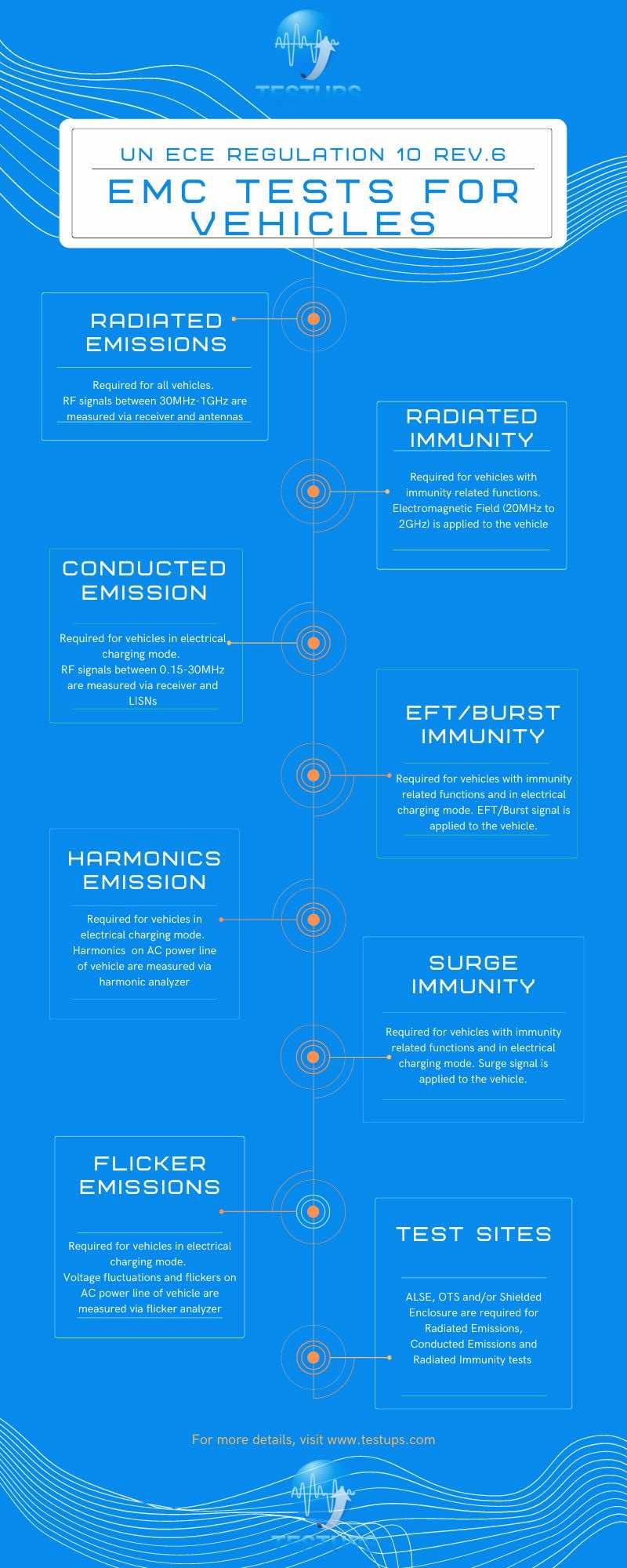
Which countries are covered by ECE R10?
There are 57 countries which are under the scope of UN ECE Regulation 10. Each country has a ECE symbol and designated type approval authority. For instance for Ireland, ECE symbol is E24 and designated type approval authority is NSAI. For whole list of ECE R10 countries visit this page: ECE R10 Countries
Costs of EMC testing and type approval certification
There are two cost item for ECE R10 compliance: testing & test report and type approval certification & certificate
What are the costs for ECE R10 EMC testing?
EMC testing costs depend on the features of the product, test plan, and location of test laboratory. If your product is a simple Electronic Sub Assembly (ESA) or component which has no immunity related function, reduced EMC tests are allowed. This will make testing costs lower. For such a simple product operating at a single voltage (12V or 24V) and with a single operation mode, ECE R10 testing costs would be around $3.5k. Testing costs of vehicles are more than testing ESAs or components. EMC testing costs directly depends on the test duration and labor cost, thus the country in which the tests is also essential.
What are the costs for ECE R10 Type Approval?
Type approval costs depend on the agency or country issuing the type approval. Although E1 (Germany) and E24 (Ireland) marks are technically identical, E1 marking takes some much more time and a bit expensive than E24 due to authorized agency costs. ECE R10 type approval (E marking) costs will around $1.5k.
How to reduce ECE R10 testing costs ?
If you are suffering from the costs for ECE R10 testing and type approval, take into account suggestions listed below:
- Be familiar with ECE R10 and applicable EMC tests for your products. Download ECE R10 itself, guides, work on it and match the requirements with your products.
- Check ECE R10 EMC tests during the design stage of your products. Early testing would save you time and money since you would have opportunity to get test results before serial production.
- Use same or similar electronic components when designing your products. Using similar electronic components would increase the probability of the PASS ratio of test results. If you use various types of electronic components, ensure that they have been EMC tested or certified.
- Group similar products in terms of electromagnetic compatibility and reduce number of model names with product family names. ECE R10 allows product grouping if technically applicable. When defining your product model names, try to group them under a product family model names.
- Start testing with pre-compliance EMC tests during design validation stage of your products, this would save time and cost during ECE R10 certification. If an electronic product or vehicle never tested before, it would probably fail at one of ECE R10 tests. Pre-compliance testing would save you time and money even it seems causing extra costs.
- Try to perform some EMC tests in house by having EMC test equipments (if you regularly need ECE R10 testing or type approval service). Work on investing on some of the EMC test instruments and prepare test setups which are most essential for your product. By in house testing, you would get opportunity to design your product more comfortable and to check your product’s EMC performance during its pilot or serial production.
- Build a UN ECE R10 compliant EMC test laboratory (if you have various products that need ECE R10 testing or type approval service). UN ECE R10 compliant test laborotory needs some expert staff like test engineers and technicians. If your team can handle these laboratory operations, building a new test laboratory would make you much more comfortable in terms of electromagnetic compatibility of your products. If you would like go further, have accreditation or authorisation for your laboratory to show your lab’s independency and satisfy your customers.
What is Conformity of Production (CoP)?
The manufacturer is responsible for ensuring all the products manufactured, sold and registered in the applicable market conform to UNECE Regulation 10. CoP is a means of evidencing the ability to produce a series of products that exactly match the specification, performance and marking requirements outlined in the type approval documentation. Whether you are a manufacturer, or the agent applying for approvals on behalf of a manufacturer, and whatever your product is, suitable CoP arrangements must be made. Your CoP inspection report or certificate will be checked during the ECE R10 type approval certififcation. If this report or certificate is missing, you can have this service from an accredited body or from us. We are partnering with certification agencies who are capable of inspecting and issuing CoP certificate.
How to prepare for ECE R10 Certification?
Four tips you should do prior to ECE R10 Certification of a product:
1. Finalize design and prepare technical documents of the product
2. Apply some pre-compliance EMC tests to your product (you can either perform some EMC tests in house or hire an EMC laboratory for pre-compliance EMC tests)
3. Set a budget and time schedule for ECE R10 EMC tests and type approval certification
4. Prepare whole document set (product, company, quality, conformity of production)
If you consider above tips your ECE R10 certification process will be smooth.
Is there any guide related to ECE R10 Certification?
Yes, we published a free guide, explaining ECE R10 certification processes. You can reach this guide by visiting the link below. The link will direct you to download page of ECE R10 Certification Guide:
We prepared a free guide for you. Learn more about UN ECE R10 and certification.
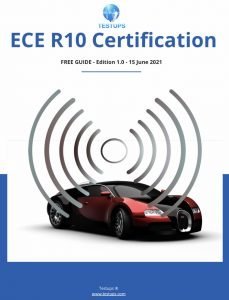
Do you need EMC Testing and/or Type Approval Certification Service?
With our partner ISO/IEC/EN 17025 accredited or authorized EMC laboratories in United States, Italy, Poland, United Kingdom, Turkey and China, we are offering EMC testing services according to ECE R10 Rev.6. After receiving your product sample (electronic sub assembly, component or whole vehicle) to the laboratory address, ECE R10 EMC tests will be finished in approximately 4 weeks. You will get an EMC test report at the end of testing stage.
In addition to EMC testing, if you also need type approval or E marking service, let us know. We are able to offer this additional service. We are offering E1 (Germany), E11 (UK), E20 (Poland), E24 (Ireland), E32 (Latvia), E37 (Turkiye) marking/type approval services with our partner designated services. Contact us, one of our EMC certification experts will contact you and send a quote specific to your ECE R10 requirements.
For quoting, we need below details of the product to be subjected to ECE R10 EMC tests and type approval certification:
Product Name / Model(s):
Description /Application:
Number of Configurations to Test:
Desired Country / Regional Markets:
Approx. Device Set-up Time:
Please provide a general description of function of this device and how it interacts with the vehicle:
Is this after-market equipment?
If yes, does the device interface or relate with the safety features of the vehicle? If yes, please explain
Does this device connect with the “can-bus” of the vehicle?
Is this device grounded or floating?
If grounded, how is it grounded to the vehicle?
Support and host equipment needed for testing?
Weight of Device:
Length of Device:
Height of Device:
Width of Device:
Highest Clock Frequency in Device
Is the device battery powered?
Does Device Receive power from the vehicle? (If yes, what is the voltage?)
Amperage?
Do you have Control of Production (CoP) Inspection Report or Certificate?
Manufacturing company and location of the product:
Type Approval Certificate holder company name and address:
When asking a quotation from Testups, please send us above details or a document showing the answers to above product details. EMC testing and type approval certification costs depend on the answers of the above questions.
ECE R10 Testing and Type Approval Services
with accredited partners of Testups
Do you need EMC Test Systems in order to perform ECE R10 Tests in house?
If you often need EMC testing in house or if you have various products to be tested and certified start investing on an EMC laboratory compliant with ECE R10. This would empower your EMC skills and shorten product development stages.
When you are ready to invest on EMC test systems to build your laboratory in order to perform ECE R10 tests for your products, we are ready to offer turn-key solutions for you. We are offering EMC anechoic test chambers, screened test rooms, shielded tents, amplifier rooms, EMC test equipments like EMI receivers, antennas, LISNs, signal generators, amplifiers and CDNs, RF cables and test software required for all EMC tests listed on ECE R10.
We are offering both vehicle EMC test systems and ESA EMC test systems. When you send us electrical and mechanical features of your product to be tested, we will offer best configuration that fit your and ECE R10 requirements. Performing EMC tests in house would make your product launch durations shorter and give you great opportunity to develop your designs.
ECE R10 Test Setup Requirements for Vehicle EMC tests (19-page Guide)
ECE R10 Test Systems and Chambers
with manufacturer partners of Testups

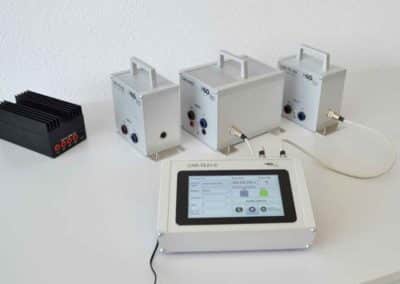
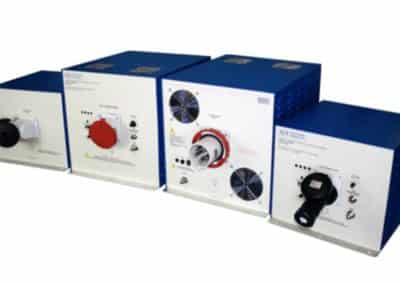
Recent Comments